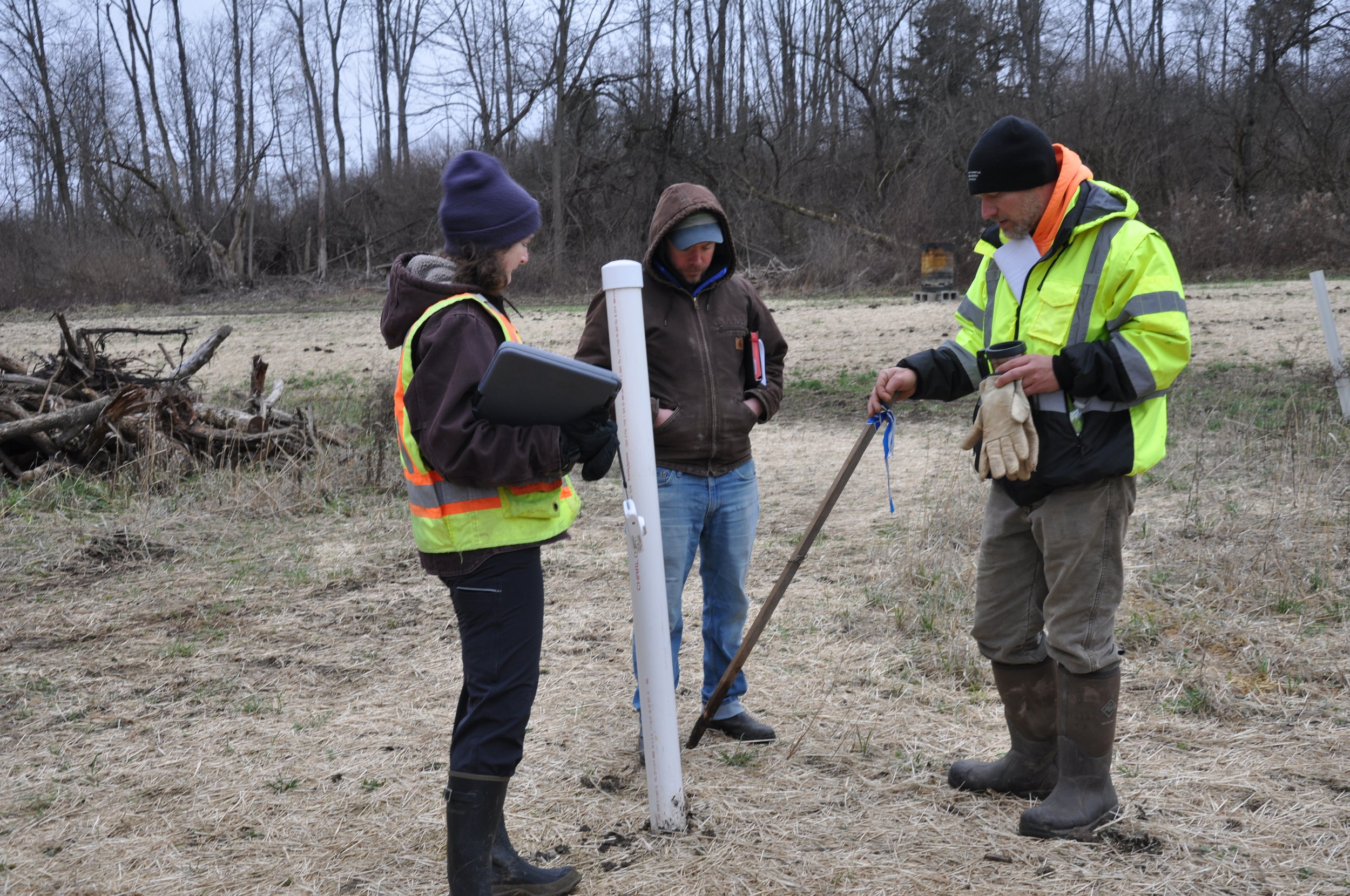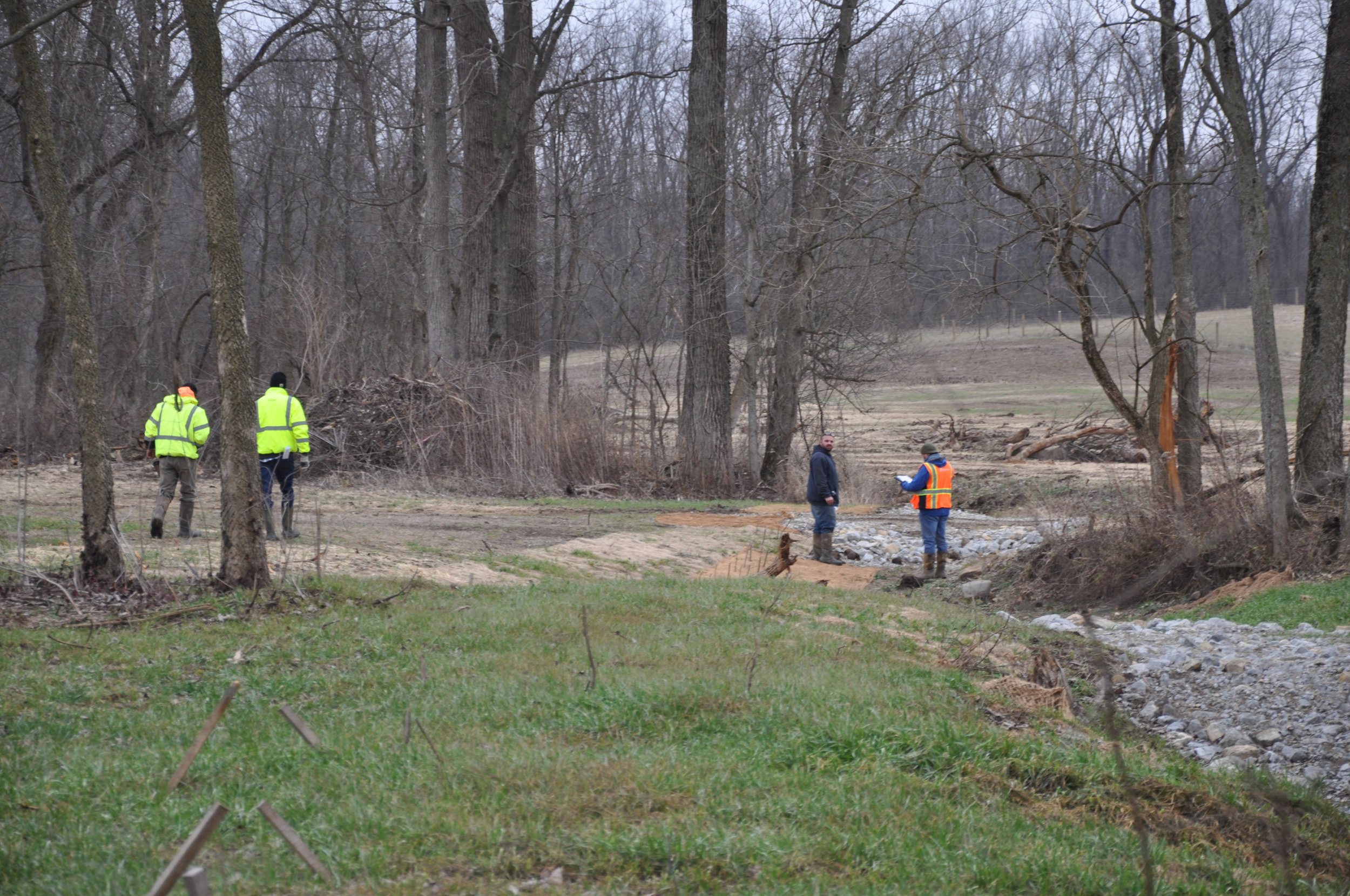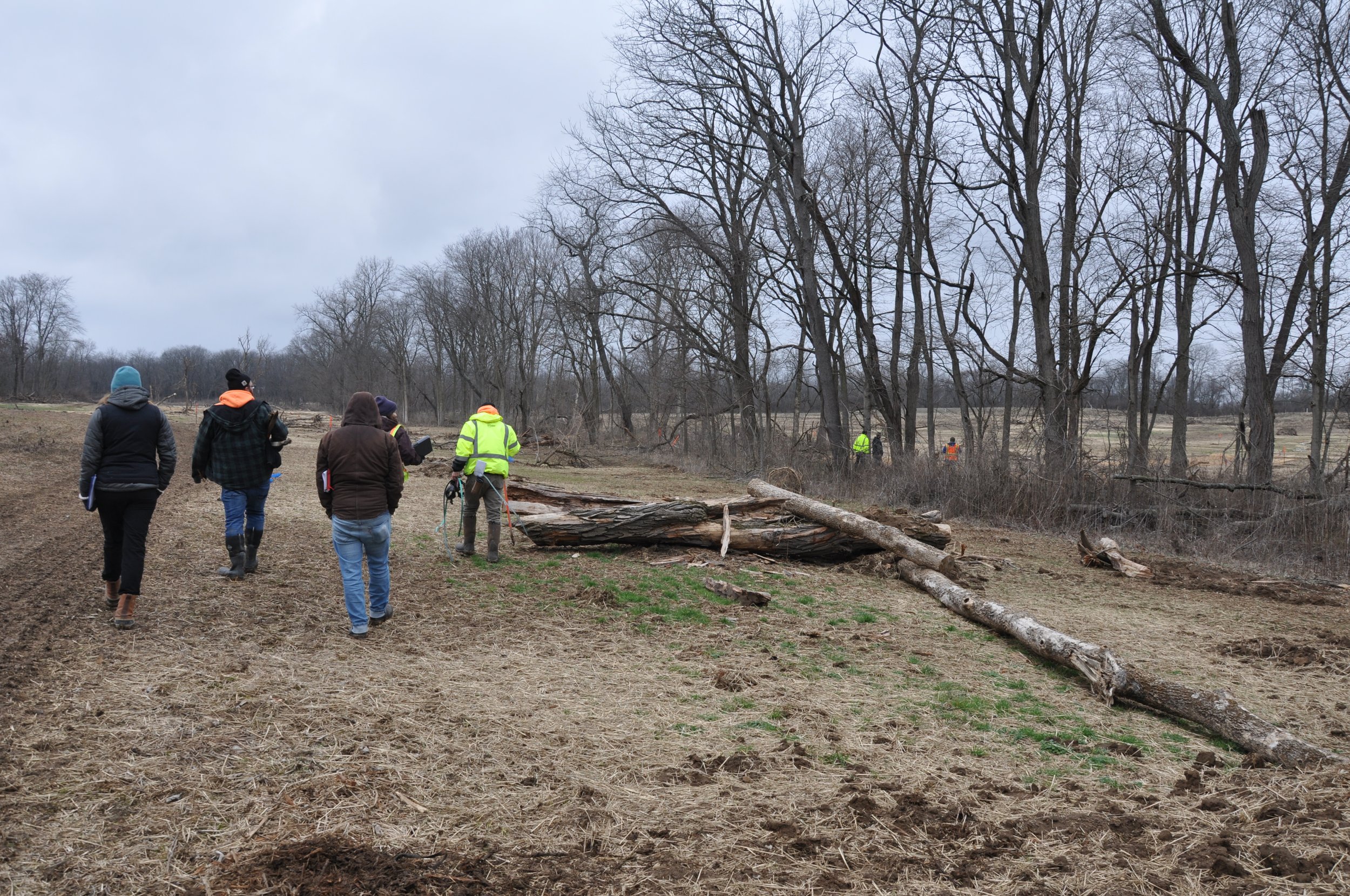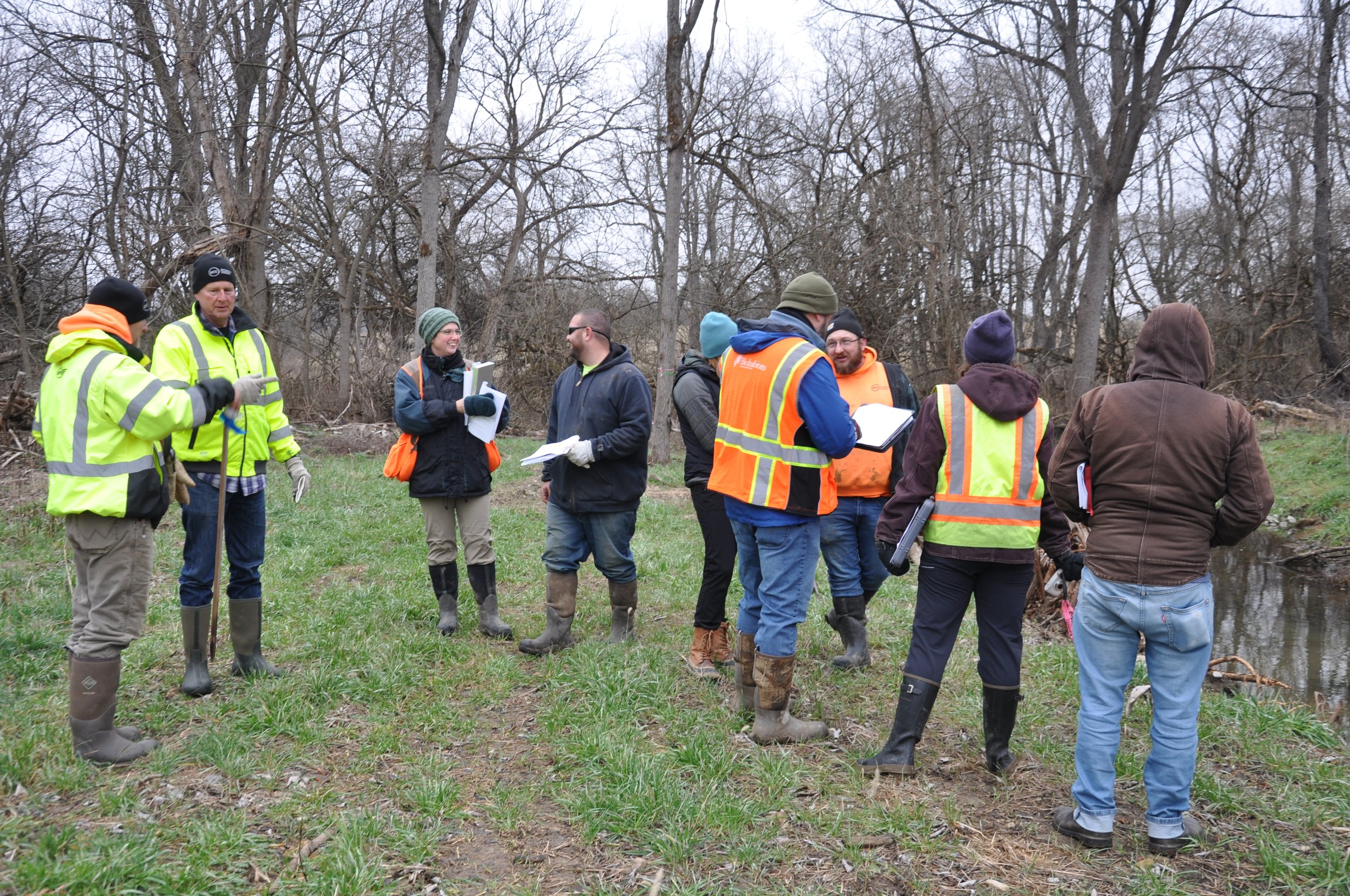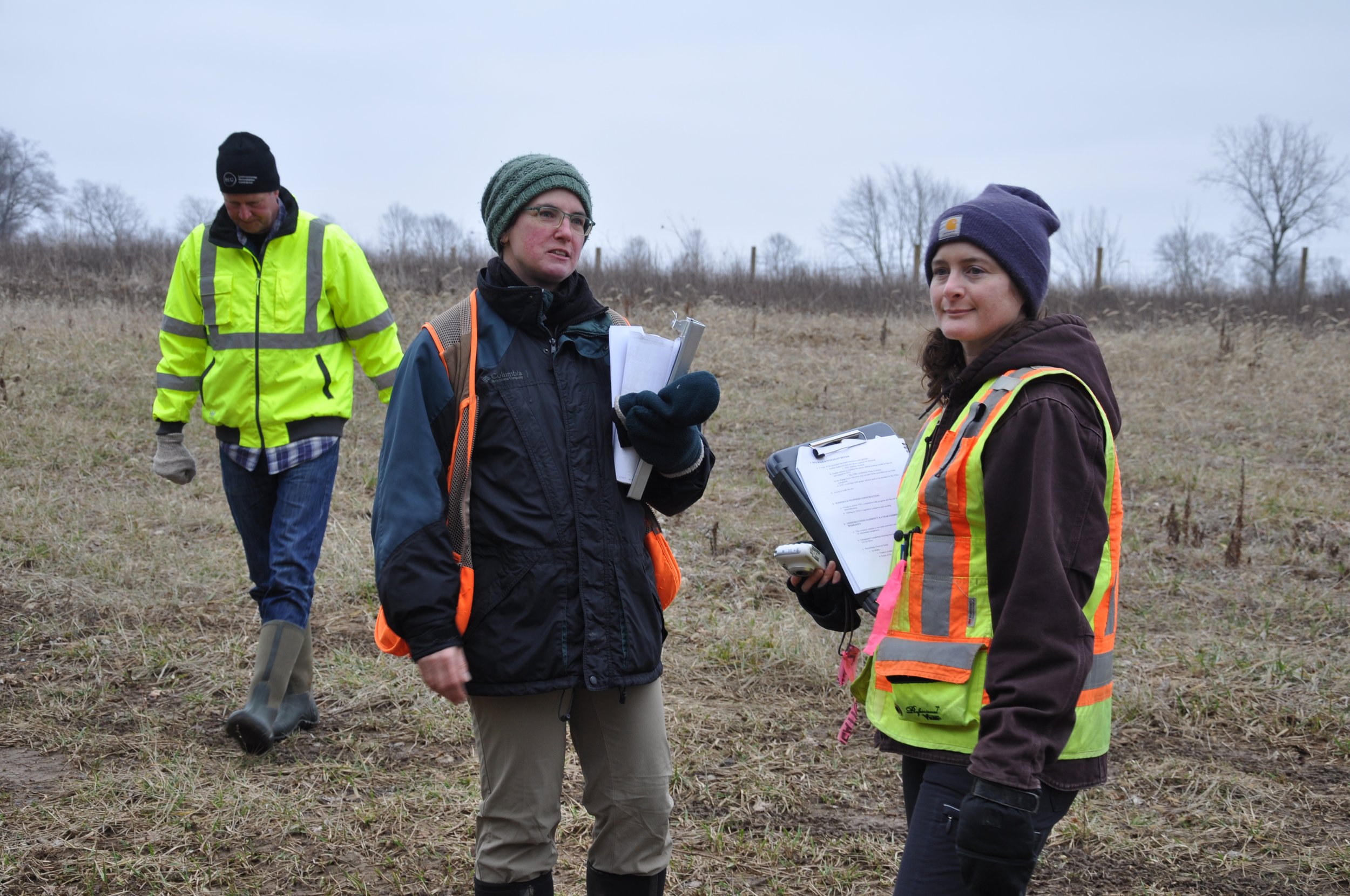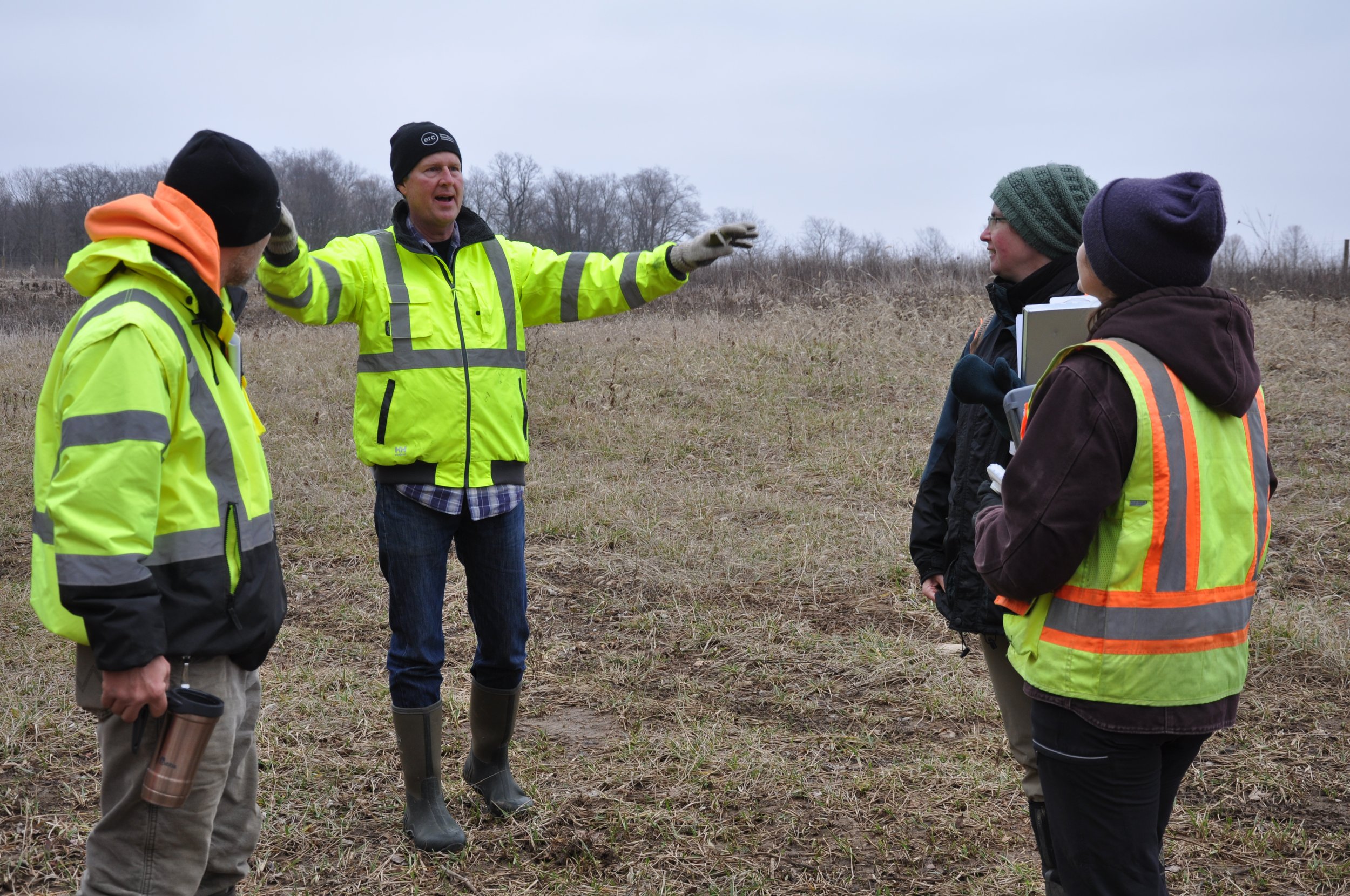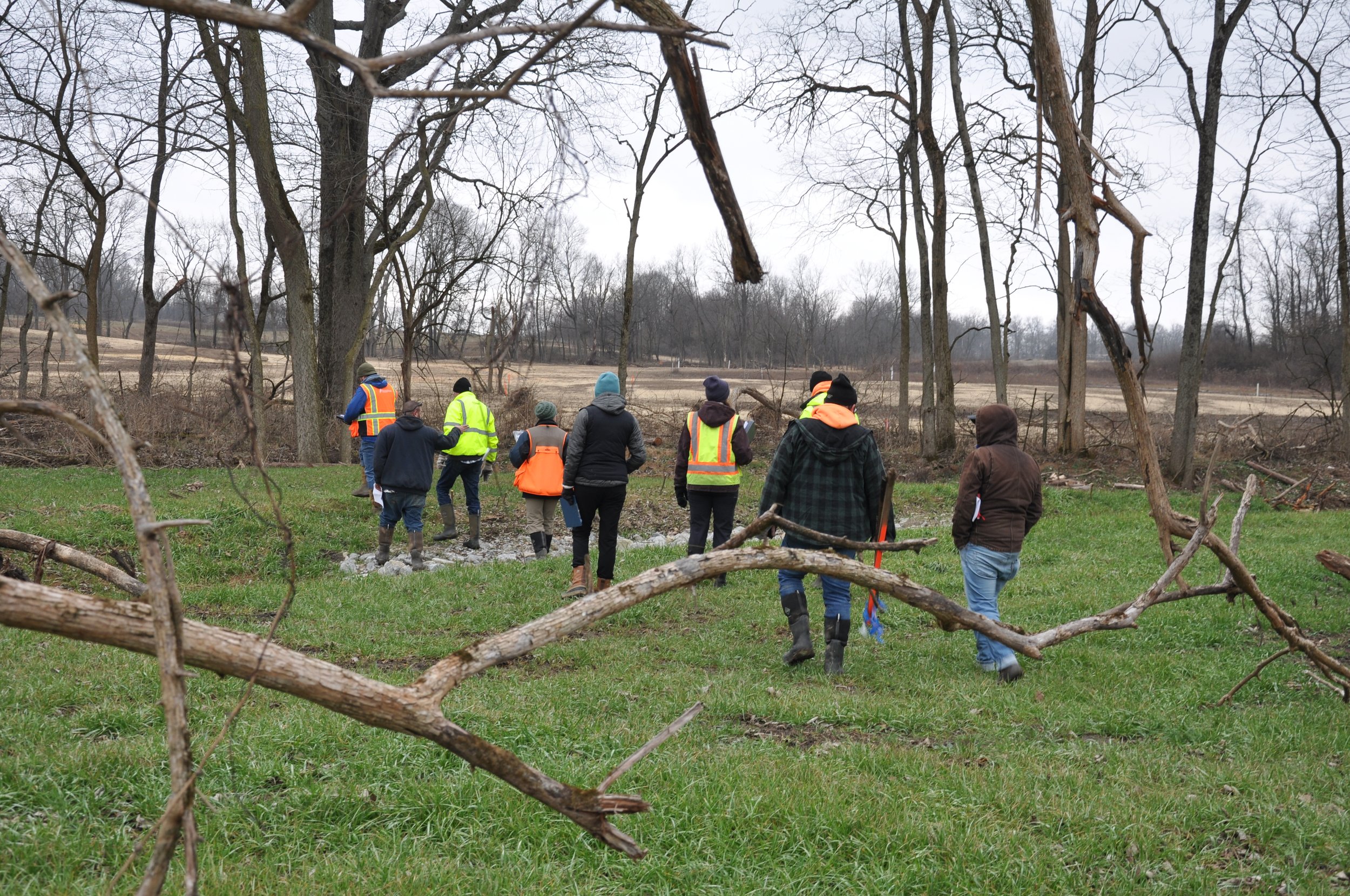Glimmer of the Future: Construction Completed on Jacoby Branch Restoration
Amelia Harris of TNC and Suzanne Hoehne of Biohabitants discussed features of the re-meandered Jacoby Branch at a project walkthrough on Jan. 6. (All photos by Audrey Hackett)
By Audrey Hackett
The “100% completion” meeting began with donuts and hot coffee from the back of a truck. Gathered at Agraria’s Huston Road entrance on the cold morning of Friday, Jan. 6, were stakeholders from The Nature Conservancy, Biohabitats, Environmental Remediation Contractor, and Agraria. I joined to take photos and notes for this account. After a few preliminaries, a two-hour site walk took participants through the rebuilt stream system that represents the now-completed construction phase of the Jacoby Branch restoration, a 10-year, $2 million project led by The Nature Conservancy, or TNC.
Jacoby Branch and its tributary streams were profoundly disrupted by decades of intensive agriculture on the land that now forms Agraria. To repair that damage and coax the stream system and surrounding land to new life, TNC and its contractors are re-meandering streams, restoring and reestablishing wetlands, and reforesting 60 acres. These efforts ultimately will improve the health of waters that enter the Little Miami River in our home watershed.
Project planning began in 2017. The first trees were felled last March, and construction began in June. As of early January 2023, construction was complete; the walkthrough formally closed the construction phase and gave project partners a chance to see in detail the morphology of the rebuilt streams, wetlands, and buffer zones. The project enters a new phase later this month with intensive seeding and planting of native grasses, forbs, shrubs, and trees. Monitoring of various aspects of the site will continue for 10 years. For this purpose, visitors to Agraria may notice white PVC pipe photo stations and orange-topped profile monuments (a form of marker) for stream and wetland monitoring. In addition, Agraria is exploring opportunities for “crowdsourced” citizen photo stations that would aggregate a time-lapse view of the land’s change over time.
‘Incredible change’
“It’s an incredible change,” Agraria Outreach Director Alexandra Klug, who is overseeing the project for Agraria, reflected several times during the walkthrough.
Jacoby Branch and its five feeder streams on Agraria’s property have been substantially rebuilt, adding sinuosity (curves and bends) and riffles, among other features, to reverse the previous drastic straightening that occurred when the stream system and surrounding lands were modified for intensive agriculture. Some of these streams are perennial, others are intermittent. The presence, and absence, of water was the focus of frequent comments on Friday.
“Where’s the water?” “It was here Tuesday, but it’s gone today.”
Some stretches of the reestablished streams were dry, others moist, and still others had flowing water. The upper pools of Jacoby Branch behind the Agraria Barn were high, and several built-up riffles (rocky or shallow areas) had water flowing over them. ERC employee JT McMullen said he has observed frogs, tadpoles, aquatic invertebrates, and various species of fish in the pools.
“We have to be patient” with the water, lead designer Suzanne Hoehne, of Biohabitats, emphasized. Previous channelizing, or straightening, of Jacoby Branch and other streams had dramatically changed original water levels and flows, and the restorative re-meandering would do so again.
“The success of ecology is change,” Hoehne reflected, adding that the interplay of land, water, and weather would necessarily modify the project, a step in turning the built environment into a living system.
“When you see lots of water, take pictures!” she instructed, with a laugh.
In rebuilding the stream system, about 3,000 tons of limestone, sand, and gravel, sourced from a quarry in Cedarville, were put into the ground. That massive earth- and rock-moving effort required heavy equipment, frequently seen and heard on Agraria over the past seven months. With the construction phase complete, that equipment is moving out this week. A greater tranquility will prevail.
Trees felled, and planted
Another major change through the course of the project has involved vegetation. Most strikingly, many trees and shrubs in the riparian corridors were taken down to make room for new plantings of native trees. Some of the trees and shrubs were nonnative; others, such as Osage Orange, were natives beloved by some but excluded from TNC’s federally set reforestation criteria. The tree felling was emotional at Agraria.
Hackberry, cottonwood, and Osage Orange were the predominant tree species on the property prior to the restoration effort. Felled trees were used in stream construction, helping to shore up, shape, and add complexity to the new streams. Wood from the property has also been heaped up to form brush piles in the landscape, an important habitat element for birds and small mammals. These piles will decay over time, adding organic material to the soil. And some of the felled trees have been “replanted” as upright snags across the property. These offer perching spots for birds, especially raptors, and constitute a striking visual feature — sinuous, towering, mysterious.
Toward the end of the construction phase, ERC planted 5,000 “live stakes” along streambanks, branches of native trees cut while the trees are dormant and placed directly in the soil. Nine species have been planted this way, including several willows, dogwoods, sycamore, and buttonbush. As if by magic, these “stakes” will root and grow into trees and shrubs. ERC has also seeded the riparian, wetland, and buffer zones with seed mixes suitable to each, as well as seeding some areas with cover crops to help prevent erosion.
Erosion is one danger the restoration project will have to, so to speak, weather, according to Hoehne.
“This is the most vulnerable point,” she said on Friday. The stream system has yet to be anchored by vegetation, but even one growing season will make a difference in the stability (not to mention beauty and functionality) of the restored areas.
Beginning later this month, TNC will be overseeing an intensive seeding and planting effort, Amelia Harris, a TNC restoration ecologist, said on Friday. As part of that reforestation, approximately 17,000 young native “bare root” trees will be planted by contractor Williams Forestry — one every four feet in some areas.
“We won’t be able to walk over this ground,” Harris commented, noting that saplings would soon be poking out of the soil. But decades from now, if all goes well, a thriving native forest will grow up where now the earth is straw and mud.
As a unique feature of the project, Agraria will be planting additional native trees and shrubs in an extended buffer area. Agraria Land Director Jeremy Schleining reflected that the extra buffer will allow Agraria to integrate agroforestry practices into the project, managing and harvesting a portion of the reforested land.
Another vegetative-related challenge has been invasive species (which Agraria frequently refers to as “out of place” species). A consequence of human land disturbance and other factors, these nonnative plants crowd out native flora, which are species adapted to local conditions that provide essential food and habitat for pollinators, birds, and mammals. To prepare the ground for reseeding with native species, TNC used a combination of discing to break up roots and herbicide applications to kill species such as Canadian thistle, an especially tenacious “out of place” plant covering wide areas of ground. While herbicide use remains standard in ecological restoration projects, it has prompted questions and reflections here at Agraria. It is hard to witness the same methods that damaged the land used in rehabilitating the land. Yet it is also hard to witness the runaway growth of nonnative species — a harm to the local ecosystem and a profound barrier to healing the land.
Glimmer of the future
Friday’s walkthrough ended in the southwest corner of the property off Huston Road, site of an especially super-sinuous re-meandered stream. There as elsewhere, thick woven matting had been put down to keep soil and seeds in place. However, the matting didn’t necessarily prevent squirrels from wresting seeds out of the mesh. Shaking his head, ERC’s McMullen pointed to little holes dug at the edge of the matting as clear evidence that squirrels were doing just that.
Walking back to my car, I reflected that it takes faith and imagination for a farmer to see the bounty of August in January’s cold fields. And lots of skill and hard work to get there.
That distinctly agrarian dynamic applies to this restoration project. Squinting back at the gentle rise and fall of the land threaded with new gravel-lined waterways under low gray skies, I almost saw the glimmer of water. I almost saw the return of a forest. I almost saw the future that will — with the farmer’s recipe of luck, skill, patience, care, and time — grow into ripeness like tomatoes in July and eggplant, peppers, and okra in August.
*Audrey Hackett is editor of Agraria Journal.
JT McMullen of ERC walked streamside along a re-meandered stream on the southwest corner of Agraria. Matting, seeds, and “live stakes” provide stability and the promise of future vegetation.


